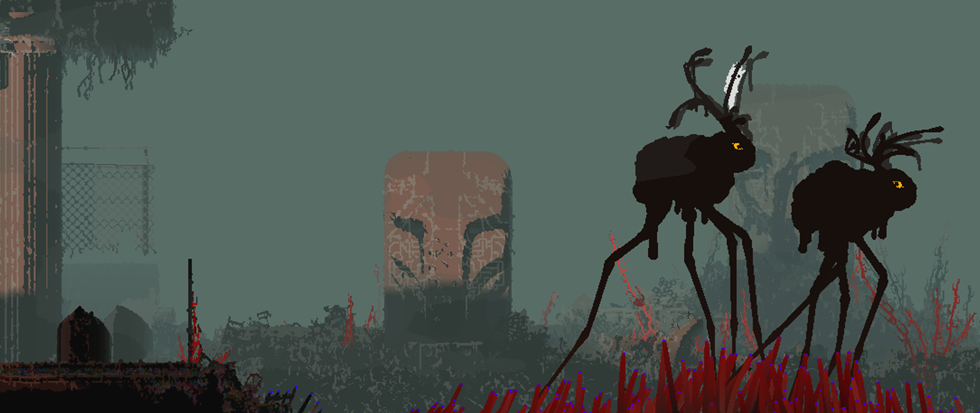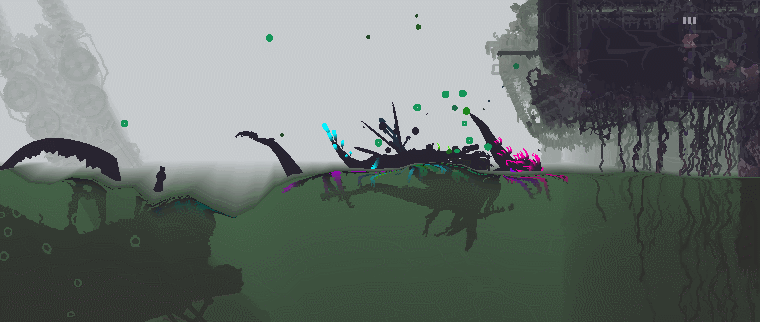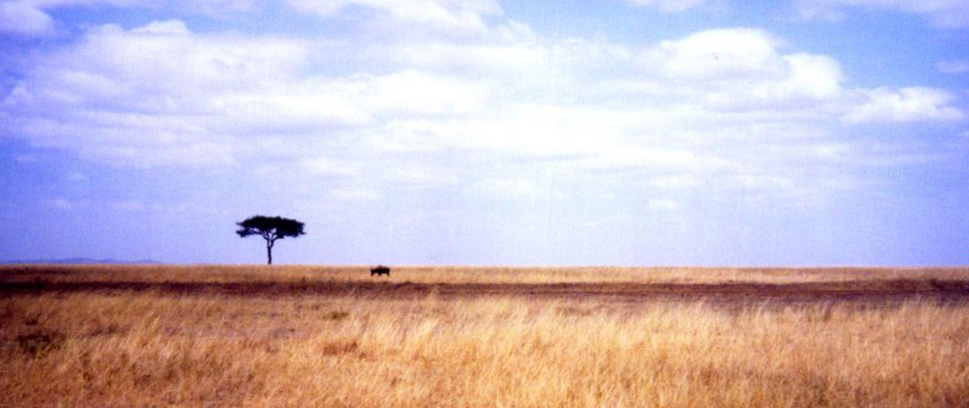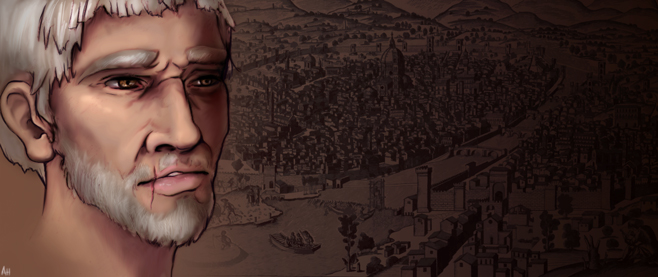
Rain World’s Brutal Metaphysics
The fascinating thing about Rain World’s post-apocalyptic setting is that it was a glorious success. The world left in ruins, the abject decay of buildings, factories, communications complexes, temples, and the utter disappearance of intelligent life—all of this was according to plan. The marvellous thing about Rain World is that this plan was good.
The game’s narrative is essentially one of self-abnegation: the player’s character—the slugcat, a white cat/ferret analogue—begins the game separated from their family, swept by a flood into a desolate, post-industrial wasteland. Despite its urban backdrop, this environment has regressed entirely into a naturalized ecosystem: among the rusted out machines are the nests of predatory lizards; massive, smoke-spewing vultures swoop down like falcons; carnivorous, pole-like plants are almost indistinguishable from long segments of rebar until you try and climb them. In this ecosystem, the slugcat occupies the lowest rung—above only bats and smaller insects. In this vein, the game’s initial goals are relatively simple: avoid being eaten, scavenge enough to eat, and find a safe hibernation zone before the recurrent apocalyptic rain returns.
But that is not all to the story. Accompanying the slugcat is a yellow worm who provides assistance in the form of holographic icons that point out food, threats, and places of safety. More importantly, the holograph also suggests directions and tries to communicate a purpose through a succession of hazy images. Though following its directions is entirely optional, doing so takes you through different zones—a massive dumpyard, the corridors of a lightless crypt, the scalable side of a skyscraper— to the heart of a massive decaying supercomputer. The intelligence in the computer—after some invasive surgery so you can understand it—will tell you the only way out is to the west, and then deep, deep underground.
What “out” means in this context is surprisingly broad. The intelligence—Five Pebbles—cryptically explains that life is a recurrent, stagnant cycle, “a repeating pattern. You want a way out.” Another character—Looks to the Moon—elaborates if you bring her the right item: “Then you know that death isn’t the end—birth and death are connected to each other like a ring, or some say a spiral. Some say a spiral that in turn forms a ring. Some ramble in agonizing longevity. But the basis is agreed upon: like sleep like death, you wake up again—whether you want to or not.” At another point, she’ll say: “You know that nothing ever truly dies though, around and around it goes.” Arguably, the image the game presents is beyond that of reincarnation; dying does not mean a rebirth, but a re-awakening into the very same life, the very same moment. “Out” then means not merely a way out of the ruined landscape, but a way out of the world, the tedious shuttling between life and death.
Re-awakening after death is also literal description of the player experience. Rain World is infamously difficult, a world where death is common. The slugcat has no natural defenses against crocodiles, vultures, spiders that nightmarishly combine to form a centipede, and a massive, multi-limbed horror that, in the developers’ words, combines the idea of the spider with its web. While there are methods to deal with each type of creature (some variant on run and hide) the game does not play fair: you may enter a room to find a lizard ready to snap you up before you can react, or a mistimed jump will let you fall to your death without any recourse. You play the hand you are dealt, and Mother Nature does not deal fair.

But every time the player dies, they wake up in same safe room they started out in because “like sleep like death, you wake up again—whether you want to or not.” An otherwise unmentionable videogame convention is transformed into an expression of metaphysical dread. When the player drowns because too many leeches latched on and needs to start the day again or is leapt on by a wolf-spider/porcupine chimera, this failure is not a misstep or a false future, to be rectified ‘on the next life; it is the visceral, immediate past. Diegetically, the terror and exhaustion of being devoured by spiders in the darkness is remembered when the slugcat wakes up. The circle of life is not a metaphor for the operation of an ecosystem, but a lived reality; sometimes you are prey and sometimes you are predator—but you will remember either way.
Second-hand or simulated experiences like Rain World are the only way we in the Western World can actually imagine with any meaning an animalistic life. Outside of metaphor, we do not have to worry about predators hunting us; we do not—or morally speaking, should not—worry about starvation. In a word, we are free from the food chain. We are not, however, free from suffering, which is why reincarnation or rebirth has its own special terror. When, according to legend, Gautama Siddharta left his sumptuous palace for the first time, he was introduced to the idea of suffering by the sight of a decrepit old man. Samsara—the Sanskrit word for the cyclical nature of death and rebirth—guarantees by its recurrent nature that very suffering, which Buddhism offers an escape from. This is not only an eastern idea, mind—Plato’s myth of reincarnation required drinking from the Lethe (the river of forgetfulness) before the soul desired life once again—but it finds live expression in Buddhist thought. Freedom from the cycle is to be found from detachment from life itself; only then can one be free from suffering and, eventually, the sterile circle of life and death.
Returning to Rain World, this freedom was the goal of the game’s precursor civilization. They could articulate their endless, circular rebirth, but wanted to escape from it. On the one hand, this was a world of hyperbolic material excess: one message confirming receipt of an automatic shipment of beverages begins, “On regards of the (by spiritual splendor eternally graced) people of the Congregation of Never Dwindling Righteousness, we Wish to congratulate (o so thankfully) this Facility on its Loyal and Relished services” and so on. There are references to absurdly ornate masks (“Some public persons did have problems with narrow doorways”). But on the other hand, despite this level of material wealth there persisted a desire to escape the world entirely; despite their comfortableness, the desire to be free of the recurrent cycle of death and rebirth was no less present. Some sought to break the cycle through self-abnegation and elimination of the ego—hence the need for rites designed to help individuals shed “the five natural urges which tie a creature to life.” Eventually, a substance called Void Fluid was discovered beneath the surface that dissolved both the literal and metaphorical ties that bind, freeing one from the cycle of constant rebirth. One could skip the rituals entirely and simply take a void fluid bath; the world is empty, so their apocalypse was a success.
But Rain World only tells this story obliquely, and even then the game is really about the slug cat’s suffering—not the familiar emotional aches and pains, but visceral, red-in-tooth-and-claw suffering. For Rain World’s cycles and repeated pattern of death and reawakening is exhausting. To play the game is to try to climb for the umpteenth time a stretch of vertical canopy called The Leg, to sneak past that monster that combines the spider and its web. Waiting is not an option: there are two more monsters right afterwards, and you only have so long before the rain comes to drown you. So you throw a stone to send it down, but you mistime the jump and land too close to its hideously languid tendrils; it plucks the slugcat up and inserts it into its mouth. Press space to start again, to wake up again, to climb up again, to be devoured again, to be crushed again, to start over once again, over and over. It is a frustrating, dispiriting, exhausting, nerve-wracking experience that—though punctuated by a few successes—recycles its fraught emotional content.

This experience extends to the rest of the ecosystem as well. The slug cat will compete with flying cuttlefish for the same prey, but both are food for lizards; vultures don’t distinguish between lizards and slug cats when they hunt. Even the world is being devoured, according to Looks to the Moon: “If you leave a stone on the ground, and come back some time later, it’s covered in dust. This happens everywhere, and over several lifetimes of creatures such as you, the ground slowly builds upwards. So why doesn’t the ground collide with the sky? Because far down, under the very, very old layers of the earth, the rock is being dissolved or removed.” The only way out is through this last act of predation: of diving into the void sea and seeing what surreal ecosystem lies beneath its waters.
All this is to say that the game presents its depiction of a the circle of life terribly seriously by emphasizing just how foundational suffering is to the model. Presenting the horror of a violent death as a recent, recurrent memory renders it eternally present—it’s an obvious point, but something outside your window has always just died, or is dying right now. Rain World’s emphasis on difficulty and repetition is meant to translate that experience to its audience in a comprehensible fashion. But the metaphor cuts both ways, and this may be the most unsettling of the game’s points: to what extent do animals know the world they live in? We understand it, but have been able to minimize its inherent presence thanks to easy aspirin and advanced medicine; what dread awaits those for whom there is no similar escape?
Sam Zucchi is a law student and occasional games critic from Canada.





